Subcutaneous parasites living in the thickness of human skin damage it and cause inflammation. They can penetrate other organs from the main "placement" site and cause serious illness. Most subcutaneous helminths occur in southern countries, and an ordinary person can be infected during a vacation or business trip there.
The danger of subcutaneous helminthic infestation is that it is asymptomatic during an incubation period that can last for years. This prevents subsequent treatment and reduces its effectiveness.
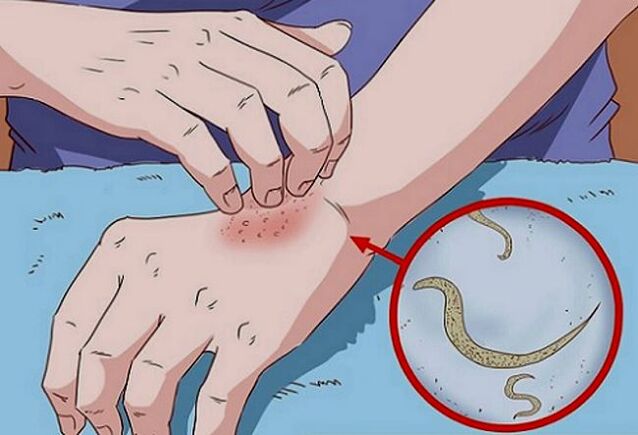
What are subcutaneous parasites
Helminths affect not only the internal organs of a person, but also the skin. Entering its thickness, they damage the epidermis, feed on its cells and defecate. Subcutaneous worm waste contains intoxication because it contains toxic substances. And the longer the worms are under a person's skin, the clearer the signs of invasion.
Subcutaneous worms cause many diseases because they affect the immune and lymphatic systems of the human body. For example, parasites can cause the development of elephantiasis. Inhibits lymph circulation in the body. This increases the size of the limbs and deforms them. In the final stage, the affected organ is covered with ulcers, necrosis develops.
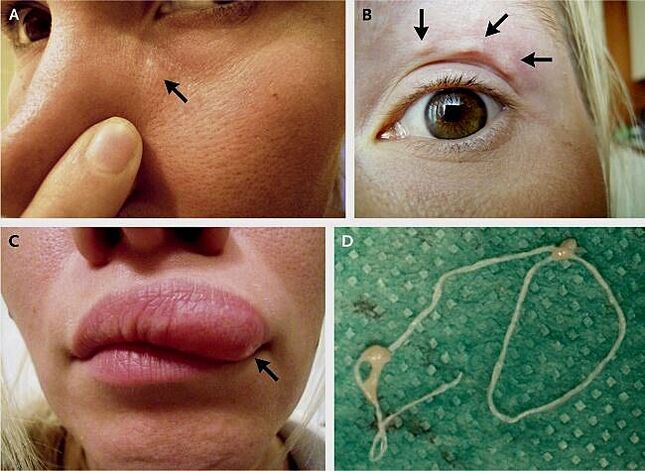
Human helminths living under the skin include:
- Nematodes of the genus Dirofilaria. Causes dirofilariasis. Infection of the body occurs by the bite of blood-sucking insects: lice, fleas, ticks, which carry larvae from one host to another. An adult dirofilaria can grow up to 30 cm in length. The process of reproduction occurs in the thickness of the skin, then the woman puts microfilaria in the bloodstream.
- Filariae. Causes filariasis. They are parasitic roundworms. An adult can reach almost half a meter, and the diameter of the body is not more than 0. 3 mm. Carriers of filariasis are blood-sucking insects that transmit parasitic larvae from one mother to another.
- Bullworm larvae. A person develops cysticercosis. Infection occurs through the intestines, where parasitic eggs penetrate along with water, food and dirt. Then, under the influence of gastric juices, their shells melt - the larvae emerge. They then spread throughout the body along with the bloodstream.
- Blood flow from the genus Schistosoma. This is called schistosomiasis. Adults can grow up to 2 cm in length. Reproduction occurs when the larvae, along with water, cercariae penetrate the body.
The main manifestations and treatment
If a person has parasites under the skin, it is primarily reflected in his condition: flabbiness appears, changes color, scars and micro-cracks appear. This is due to the fact that the "guests" damage the skin, feed on its cells and poison the waste.
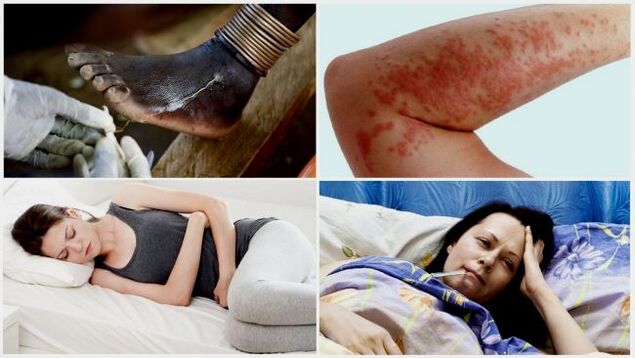
In humans, subcutaneous parasites cause symptoms of helminthic infestation:
- Allergic rashes;
- cough;
- Decreased immunity;
- itching;
- Skin peeling, redness;
- Appetite problems;
- Pain in joints and muscles;
- Sleep disorders;
- irritation;
- Apathy.
In a sick person, skin parasites cause disorders throughout the body: anemia develops, dysbacteriosis, etc.
Treatment of parasitic disease is selected individually. The choice of method is influenced by the degree of damage to the body, symptoms and type of pathogen. In some cases, in addition to medication, surgery may be needed to remove the helminth from under the skin or even from the entire affected organ.
In addition to antihelminthic drugs, antihistamines and vasoconstrictors are used. If inflammation begins due to worms living under the skin, antibiotic therapy is required.
You should not try to get rid of helminths living under the skin with the help of traditional medicine - as experience shows, they are ineffective and can harm human health.
Symptoms of filariasis
The subcutaneous worms that cause this disease - filariasis - occur in the human body after the bite of a blood-borne infected insect. Most cases were reported in tropical and subtropical countries.
These subcutaneous worms in humans are able to live in the human body and do not manifest themselves for a long time: the incubation period of the disease can last up to 7 years. This complicates the diagnosis.
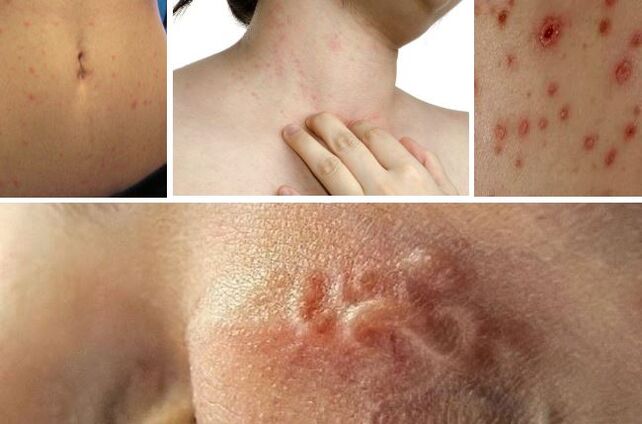
Symptoms and manifestations of the invasion appear gradually, as the parasite grows under the human skin and affects the surrounding tissues. The most common manifestations of filariasis include:
- kurdeşen;
- itching;
- warts;
- eczema;
- Small hard lumps under the skin.
As the disease progresses, fever, general weakness, headache, and drowsiness may occur.
Filariasis should be treated in a hospital setting. Antiparasitic drugs are used for drug deworming. The effectiveness of therapy is checked by a blood test. If that doesn't help, the patient undergoes surgery to restore lymph flow from the affected organ.
Cysticercosis and schistosomiasis
Tapeworm larvae cause cysticercosis. This type of helminth differs in its ability to survive: it is enough for a parasite to enter the human body, and it will soon become an adult, and then begin to multiply.
This feature complicates the treatment of the disease - if the head segment remains after surgical removal of the worm, the parasite will grow again. Although the adult tapeworm is located in the human gut, its larvae spread through the bloodstream throughout the body, including under the skin. Then they can stay there for a long time - from 5 to 30 years.
If the worms with cysticercosis are wrapped under the skin or in the muscle tissue, the disease is asymptomatic for a person. However, the location of the parasite can be determined by tumor-like neoplasms that will grow on the skin. Palpation of TB can reveal that it is hollow. The skin of the shoulders, the upper half of the chest, and the palms are usually the favorite places for tapeworm larvae.
There is no medication for subcutaneous cysticercosis, the patient should be under medical supervision. This is due to the fact that when the parasite dies after using antiparasitic drugs, toxins begin to enter the body. They, in turn, can cause severe allergic reactions.
The larvae of schistosomes, cercariae, cause schistosomiasis in humans. Infection occurs through water. The first symptoms of worms under the skin appear 10-15 minutes after the invasion. This is due to the fact that worms under the skin secrete large amounts of their own secretory fluid, which causes a toxic-allergic reaction in humans.
Early manifestations:
- Severe itching;
- kurdeşen;
- Rash.
Then there is a lull, after which (after 1-2 months) begins the acute phase of schistosomiasis, which indicates the indifference of the disease:
- Temperature;
- Nocturnal hyperhidrosis;
- kurdeşen;
- Dry cough;
- Changes in the quality of blood.
Currently, treatment of schistosomiasis is limited to the use of 2 anthelmintic drugs. In the acute stage of the disease, steroids, antihistamines, anti-inflammatory drugs are also used.
Dirofilaria and Morgellon virus
These two diseases have similar symptoms with some differences. A patient with dyrofilariasis finds a small tubercle under the skin that moves during palpation in the human body. This indicates that the subcutaneous worm has been injured in the body. The same invasion is observed with Morgellon virus.
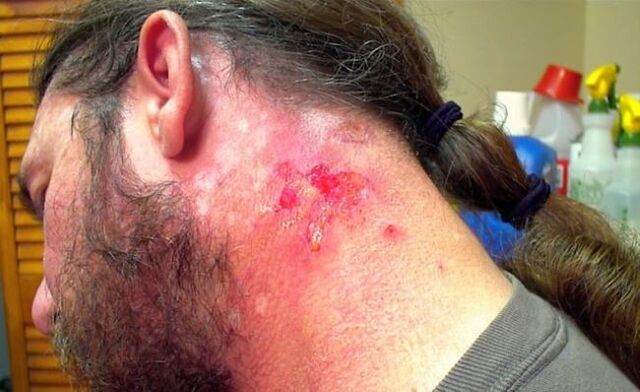
The main difference between these two parasites is that dirofilaria does not bother its owner: the blister under the skin does not cause discomfort, it can appear and disappear from time to time. Worms parasitize the arms, legs, near the eyes, nose, chest, and in men - the genitals. If Dirofilaria is under a person's skin for a long time, the body temperature rises under the influence of toxins and weakness is felt.
Severe itching is felt on the skin of helminthic infestation with Morgellon virus. In the absence of medical help, soon appear bleeding wounds, eczema. This increases the body's risk of contracting other diseases several times.
The best treatment for the parasite is surgical removal.






































